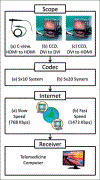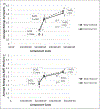Optimizing and validating the technical infrastructure of a novel tele-cystoscopy system
- PMID: 26489430
- PMCID: PMC6309348
- DOI: 10.1177/1357633X15610040
Optimizing and validating the technical infrastructure of a novel tele-cystoscopy system
Abstract
Introduction: Bladder cancer is the most costly malignancy to manage per capita due to the technical nature and intensity of follow-up. There are few urologists in rural areas, often necessitating that patients travel hours to receive follow-up care multiple times per year. We plan to train registered nurses and allied health professionals to perform cystoscopies which are monitored and interpreted in real-time by board-certified urologists. The key is to ensure optimal picture resolution to guarantee this technology is not inferior to traditional cystoscopy. Our objective was to develop the technical infrastructure needed for a tele-cystoscopy system through assessment of the transmitted video quality using expert reviewers and crowd-sourcing.
Methods: All combinations of the tele-cystoscopy system were systematically tested using a single Thiel cadaver. The videos were reviewed by expert urologists and general reviewers using a crowd-sourcing website. The video quality responses were assessed to determine concordance between each set of reviewers, and to determine the optimal equipment that should be selected for the tele-cystoscopy system.
Results: Of eight equipment combinations, only two were of high enough quality to be appropriate for medical use. We found there to be strong concordance of responses between the expert and crowd-sourced responses. The trade-offs between cost and tele-cystoscopy system component quality were compared with efficiency frontiers to elucidate the optimal system.
Discussion: We created and tested the feasibility of a tele-cystoscopy system that was deemed suitable for medical diagnosis by a group of experts. We further validated tele-cystoscopy video quality using both experts and recently validated crowd-sourcing.
Keywords: Cost benefits; crowd-sourcing; tele-oncology; telesurgery.
© The Author(s) 2015.
Conflict of interest statement
Declaration of Conflicting Interests
The author(s) declared no potential conflicts of interest with respect to the research, authorship, and/or publication of this article.
Figures





References
-
- Botteman MF, Pashos CL, Redaelli A, et al. The health economics of bladder cancer: A comprehensive review of the published literature. Pharmacoeconomics 2003; 21: 1315–1330. - PubMed
-
- Hall MC, Chang SS, Dalbagni G, et al. Guideline for the management of nonmuscle invasive bladder cancer: (Stages Ta, T1, and Tis): 2007 update. Linthicum, MD: American Urological Association, 2014. - PubMed
-
- Babjuk M, Burger M, Zigeuner R, et al. EAU guidelines on non-muscle-invasive Urothelial carcinoma of the bladder: Update 2013. Eur Urol 2013; 64: 639–653. - PubMed
-
- Waihenya C and Mungai P. Management of transitional cell carcinoma of the urinary bladder at Kenyatta National Hospital, Nairobi. East Afr Med J 2006; 83: 679–683. - PubMed
-
- Wildi SM, Kim CY, Glenn TF, et al. Tele-endoscopy: A way to provide diagnostic quality for remote populations. Gastrointest Endosc 2004; 59: 38–43. - PubMed
MeSH terms
Grants and funding
LinkOut - more resources
Full Text Sources
Other Literature Sources
Medical

